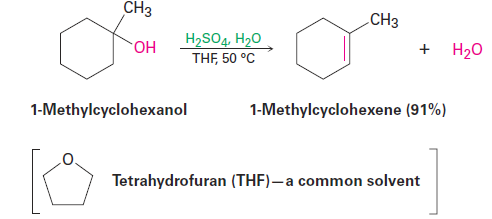


 علم الكيمياء
علم الكيمياء 
 الكيمياء التحليلية
الكيمياء التحليلية 
 الكيمياء الحياتية
الكيمياء الحياتية 
 الكيمياء العضوية
الكيمياء العضوية 
 الكيمياء الفيزيائية
الكيمياء الفيزيائية
 الكيمياء اللاعضوية
الكيمياء اللاعضوية 
 مواضيع اخرى في الكيمياء
مواضيع اخرى في الكيمياء
 الكيمياء الصناعية
الكيمياء الصناعية |
Read More
Date: 15-9-2020
Date: 21-8-2016
Date: 23-5-2017
|
Preparing Alkenes: A Preview of Elimination Reactions
Before getting to the main subject -the reactions of alkenes let’s take a brief look at how alkenes are prepared. The subject is a bit complex. For the present, it’s enough to realize that alkenes are readily available from simple precursors—usually alcohols in biological systems and either alcohols or alkyl halides in the laboratory. Just as the chemistry of alkenes is dominated by addition reactions, the preparation of alkenes is dominated by elimination reactions. Additions and eliminations are, in many respects, two sides of the same coin. That is, an addition reaction might involve the addition of HBr or H2O to an alkene to form an alkyl halide or alcohol, whereas an elimination reaction might involve the loss of HBr or H2O from an alkyl halide or alcohol to form an alkene.

The two most common elimination reactions are dehydrohalogenation— the loss of HX from an alkyl halide—and dehydration—the loss of water from an alcohol. Dehydrohalogenation usually occurs by reaction of an alkyl halide with strong base such as potassium hydroxide. For example, bromocyclohexane yields cyclohexene when treated with KOH in ethanol solution.

Dehydration is often carried out in the laboratory by treatment of an alcohol with a strong acid. For example, when 1-methylcyclohexanol is warmed with aqueous sulfuric acid in tetrahydrofuran (THF) solvent, loss of water occurs and 1-methylcyclohexene is formed.

In biological pathways, dehydrations rarely occur with isolated alcohols. Instead, they normally take place on substrates in which the -OH is positioned two carbons away from a carbonyl group. In the biosynthesis of fats, for instance, b-hydroxybutyryl ACP is converted by dehydration to trans-crotonyl ACP, where ACP is an abbreviation for acyl carrier protein.




|
|
|
|
تفوقت في الاختبار على الجميع.. فاكهة "خارقة" في عالم التغذية
|
|
|
|
|
|
|
أمين عام أوبك: النفط الخام والغاز الطبيعي "هبة من الله"
|
|
|
|
|
|
|
قسم شؤون المعارف ينظم دورة عن آليات عمل الفهارس الفنية للموسوعات والكتب لملاكاته
|
|
|